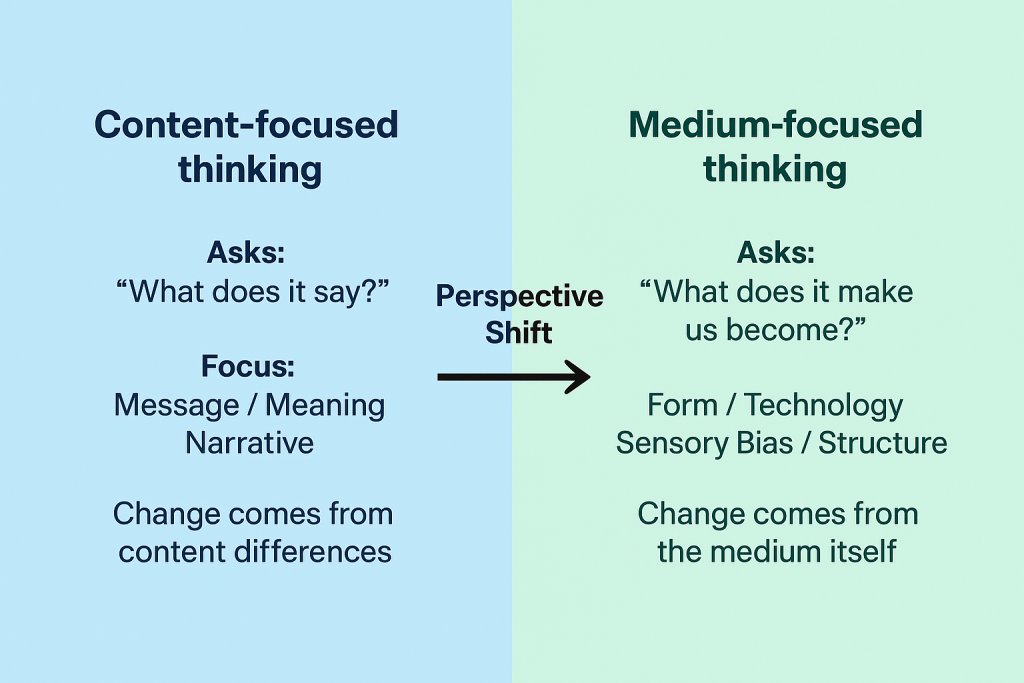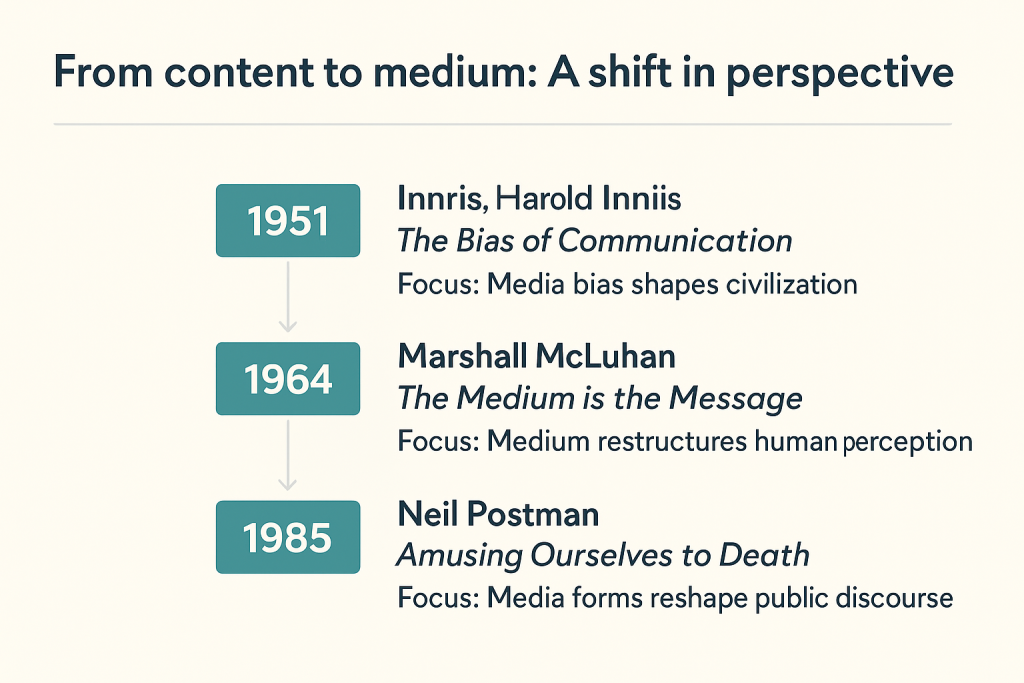Explain McLuhan’s “The medium is the message” in an animated form.
Today, we often attribute media problems to “content” such as violent programs, fake news, or corrupt information. People tend to understand media from the perspective of content, but McLuhan (1964) reminds us that we should instead focus on the “medium” itself.
Long before McLuhan proposed the idea that “the medium is the message”, Innis (1951) had already considered the “bias” of media. He pointed out that different media each have a “time bias” and a “space bias” – for instance, stable media such as stone inscriptions or parchment are suitable for long-term preservation of history and authority, while media like printing and broadcasting that can spread rapidly promote expansion and communication. The structure and development direction of a civilization often depend on the main form of media it uses.
McLuhan further pointed out that the medium itself is the message (McLuhan, 1964). In other words, the truly important question is not “what it says”, but “how it makes us see and think”. For instance, television is not merely about broadcasting programs; it makes us accustomed to thinking in images and understanding politics at an entertainment pace. Mobile phones are not just about transmitting content; they fragment our attention and redistribute our time.
By the 1980s, Postman (1985) extended this view from another perspective. He observed that the television era had turned all public discourse into entertainment – politics, education, and even news were all swallowed up by rhythm and a sense of performance. When the form of media changes, the way the entire society thinks also changes accordingly.
Therefore, what might truly matter is not what the programs are saying, but rather how this medium itself shapes us as individuals and what kind of social structure it creates. The difference between these two ways of watching is the key to understanding contemporary digital culture.

Before McLuhan put forward the idea that “the medium is the message”, Innis had already noticed the “bias” of media. He believed that each medium has its own temporal or spatial inclination. Stable media like stone inscriptions and parchment are suitable for preserving history, while media that can spread rapidly, such as printing, broadcasting and the Internet, promote communication and expansion. Therefore, the development of civilization is closely related to the characteristics of the dominant medium.
McLuhan further proposed that the medium itself is the message. That is to say, we should not only look at “what the content is”, but also at “how the medium makes us perceive the world”. For instance, mobile phones make communication immediate yet fragmented, while television enables people to understand reality through images. The medium reshapes our way of thinking.
By the 1980s, Postman pointed out that television had turned public discourse into entertainment. Politics, education, and news were all influenced by the trend of performance. Changes in media forms also altered the way society thought.
So, the question is not just “Has the content gone bad?”, but “How do media shape us”. In an era dominated by digital media, perhaps we should ask: Are we using the media, or are we being changed by them?
The ultimate medium theory reminds us that it is not just the content but the form that carries the content that influences society. Whether it is print, television, or contemporary short-video platforms, they are constantly reshaping our attention, sense of time, and ways of thinking. Understanding the medium is not just about understanding the path of information dissemination, but about understanding the evolution of human perception and cultural structure.

McLuhan reminds us that the medium itself is the message. That is to say, the form has a greater impact on social thinking than the content. This becomes particularly evident as we enter the digital age.
Let’s take a look at how this influence occurs through real-life examples.
For instance, the BBC documentary “The TikTok Effect” demonstrates how the short-video platform redefines attention and social relationships through algorithms. In the film, users do not actively choose the content; instead, they are constantly guided by the “recommended for you” system.
This indicates that the structure of the medium has participated in the generation process of thinking and behavior – we think we are watching the content, but in fact, we are being watched by the medium’s logic.
From this perspective, TikTok is not merely an entertainment platform; rather, it is a new mode of perception that determines how we define “time”, “social interaction”, and even “self-expression”. This is precisely the contemporary manifestation of McLuhan’s assertion that “media shape people”.
An example in real life
The ultimate media theory reminds us that what influences society is not just the content, but the form in which the content is presented. Whether it is print, television, or contemporary short-video platforms, they are all constantly reshaping our attention, sense of time, and way of thinking. Understanding media is not merely understanding the path of information dissemination, but understanding the evolution of human perception and cultural structure.
Innis, H.A. (1951) The Bias of Communication. Toronto: University of Toronto Press.
McLuhan, M. (1964) Understanding Media: The Extensions of Man. New York: McGraw-Hill.
Postman, N. (1985) Amusing Ourselves to Death: Public Discourse in the Age of Show Business. New York: Penguin Books.
Meyrowitz, J. (1985) No Sense of Place: The Impact of Electronic Media on Social Behavior. New York: Oxford University Press.

